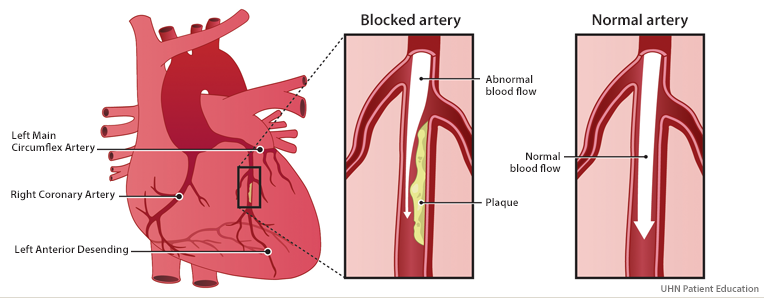What Is Angina?
The heart is a muscle. It needs blood and oxygen just like any other muscle in the body.
When there is not enough blood and oxygen getting to your heart muscle because of plaque (fatty materials, cholesterol, calcium) in the coronary artery, you may feel pain (discomfort). This pain or discomfort may be felt in many different places. You may also feel shortness of breath or fatigue.
This is angina. Angina is a warning signal that your heart is under stress. Angina occurs when there is a partial blockage in the coronary artery.
See what is happening to your heart when you experience angina (opens in new window) »

Blocked coronary artery - The heart does not receive enough oxygen-rich blood when the artery is narrowed due to a partial blockage from coronary artery disease.
A normal coronary artery allows oxygen-rich blood to flow freely to the heart
Signs of Angina
Signs (what you feel when you get angina) may be pain (discomfort) in the:
- chest
- jaw
- arms
- upper back
- throat
You may also feel shortness of breath or fatigue. You may feel these symptoms in some or all of these areas. It is different for every person and can be different between men and women.
It is important to know your signs of angina and be able to answer the following questions.
Types of Angina
Stable angina
This type of angina may occur during physical activity, under stressful situations, or after a heavy meal. Stable angina is predictable. It follows a pattern. It usually has a short duration (lasting 5 minutes or less) and is relieved by rest or Nitroglycerine.
Unstable angina
This type of angina may occur at any time; at rest, while sleeping, or with a small amount of physical effort. It is not predictable and episodes may last up to 30 minutes. Unstable angina requires immediate medical attention. If you experience unstable angina, call Emergency Medical Services in your area (e.g. in Canada dial 9-1-1).
Silent angina (or silent ischemia)
Silent angina is when there is not enough blood and oxygen getting to the heart but you
do not feel any symptoms. This lack of blood and oxygen can be seen on an electrocardiogram (ECG) of your heart. Silent angina can happen if you do not prepare your body for activity (e.g. skip your warm up before exercising). It may also occur in persons living with diabetes.

ECG of person with silent angina. ECG shows a lack of blood flow to the heart as marked by ST-segment depression (see highlighted area)
How Do I Prevent Angina When I Do Exercise?
- Take your cardiac medications regularly as prescribed by your doctor.
- Do a cardiovascular warm-up for at least 5 minutes before your exercise.
- Follow your exercise prescription (do not do more).
If you feel angina during exercise
If you get angina during exercise, follow the steps on the How to Deal With Angina During Exercise page to make sure you keep your heart safe. This information is not intended to replace the advice given by your doctor.
When to See Your Doctor or When to Call 911
See your doctor
- If you experience a change in your symptoms.
- If you have new symptoms.
- If you feel angina more frequently or at a lower level of physical activity.
Call 911
- If you experience angina that doesn’t go away after 3 sprays of Nitroglycerine.
Resources
